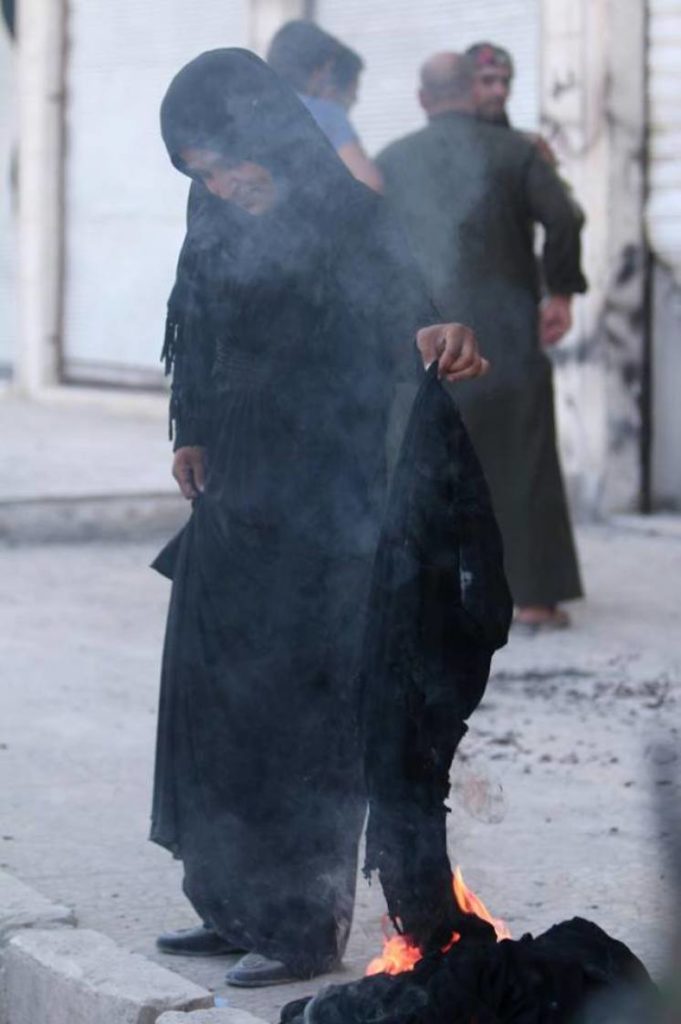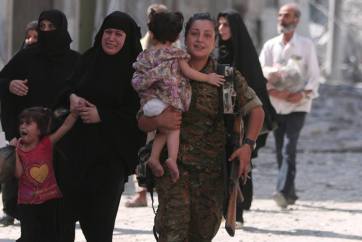We won! Mambij is free!
Correspondance from the reporters
of Revolutionary Union for Internationalist Solidarity
After two and a half months of hard fighting, and at great cost in lives lost, Manbij has been liberated. The islamofascist gangs were thoroughly defeated; the Syrian Democratic Forces – YPG/YPJ and their allies, including ourselves – have prevailed within the city and the surrounding area.
The operation for the liberation of Mambij was the hardest and most decisive battle of this five year old war (with the exception, of course, of the battle for Kobane), marking a crucial turn of events in Syria, but also for the Middle East as a whole. Manbij was Daesh’s most powerful centre and stronghold within the region, and a passageway of resupply and communication, through, as is well known, the Turkish borders and their – often shamelessly explicit – collaborators: AKP’s fascist regime. Throughout these years, Daesh has used this line through the borders and especially the Jarablus causeway, for its resupply of war equipment, funds and fighters – especially after the YPG/YPJ forces liberated Sengal, rescued the Yezidi people and cut off the northern passage between the Iraqi and Syrian territories which were under Daesh control.
To better grasp the importance of cutting off the islamofascists’ passageway from Turkey, it is worth noting that according to some rough estimates from Turkish comrades, (experienced party members of the United Freedom Forces / BÖG, on whose side the RUIS combatants are currently fighting on, and the RUIS reporters are collaborating with) about 30-50.00 Daesh militants and 3-5 million of their supporters are currently residing within Turkish territory.
Mambij was the largest city – second only to Raqqa – under Daesh control in Syria and the islamofascists had concentrated a large number of their forces and supplies within it. Given also the huge strategic importance of the city, liberating Mambij was considered a seriously difficult operation. Unlike many other cases, Daesh offered serious resistance using great amounts of fire power. Nevertheless the Syrian Democratic Forces’ tactics proved effective, and the perseverance and determination of its troops ironclad.
Although throughout the period leading up to the start of the operation the SDF had deliberately created the impression – through press statements and troop movements – that they would move towards Raqqa, on the 31st of May, they made a sudden turn and commenced their attack on Mambij. At the beginning of June, through a series of speedy surprise attacks, they took control of all the surrounding villages, encircling the city, and thus isolating it from Raqa and Jarablus. The siege of Mambij had began.
The city’s encirclement was deliberately, but also de facto (due to the considerable size of the surrounding area), not completely air tight. SDF’s positioning established an effective military control of the city from all sides – thus preventing Daesh from organising counter-attacks undetected – allowing at the same time for small units of islamofascist deserters to escape the siege,(creeping in the darkness of moonless nights) resulting in the gradual diminution of their forces.
On the other hand, Daesh gang members’ multiple organised attacks to break SDF lines, were met with fierce defence, resulting in their ultimate failure.
After a certain point onwards, through careful manoeuvring so as to limit casualties on our side, and with the (helpful indeed, yet restrained) contribution of air strikes from the International Coalition, the siege kept tightening, thus constricting the Daesh within the centre of the city. During this time, the United Freedom Forces (BÖG) sent combatants to different points of the urban centre front-line, contributing decisively to the final attack on and elimination of the islamofascist gangs.
In the afternoon of the 12th of August, the remaining gang members, in an effort to escape – and knowing full well SDF’s commitment to prioritise civilians’ safety – kidnapped a large number of civilians, mostly Arabs from the Al-Sabr neighbourhood, in order order to use them as human shields in their flight towards Jarablus, forming a convoy of about 500 cars and 400 motorcycles. SDF ordered a cease fire in order to protect the kidnapped civilians, yet some Daesh members were detected within other civilian groups and arrested.
(Sources report that soon after, a great number of the kidnapped civilians escaped and returned to Mambij, saluting in the most tangible way its liberation by SDF.)
At the same time, multitudes of suffering and injured civilians – many of which were children – were rescued by SDF, given food and water, and transported to safe areas and hospitals.
The conditions of oppression enforced by Daesh were unbearable and ordinary citizens were faced with a reality of privation and destitution.
The cleaning-up and reconstruction of the city has already began, and its citizens, relieved after being liberated from the tyranny of the islamofascists, have slowly started to return to their homes and lives. The scale of the destruction, though, is immense. The day after is a repulsive image to behold. The streets are filled with rubble and trash, even rotting corpses. Broken, demolished buildings everywhere, full of holes from bullets and shelling. Yet through the wreckage and the ruin there dawns the hope of a new better life!






